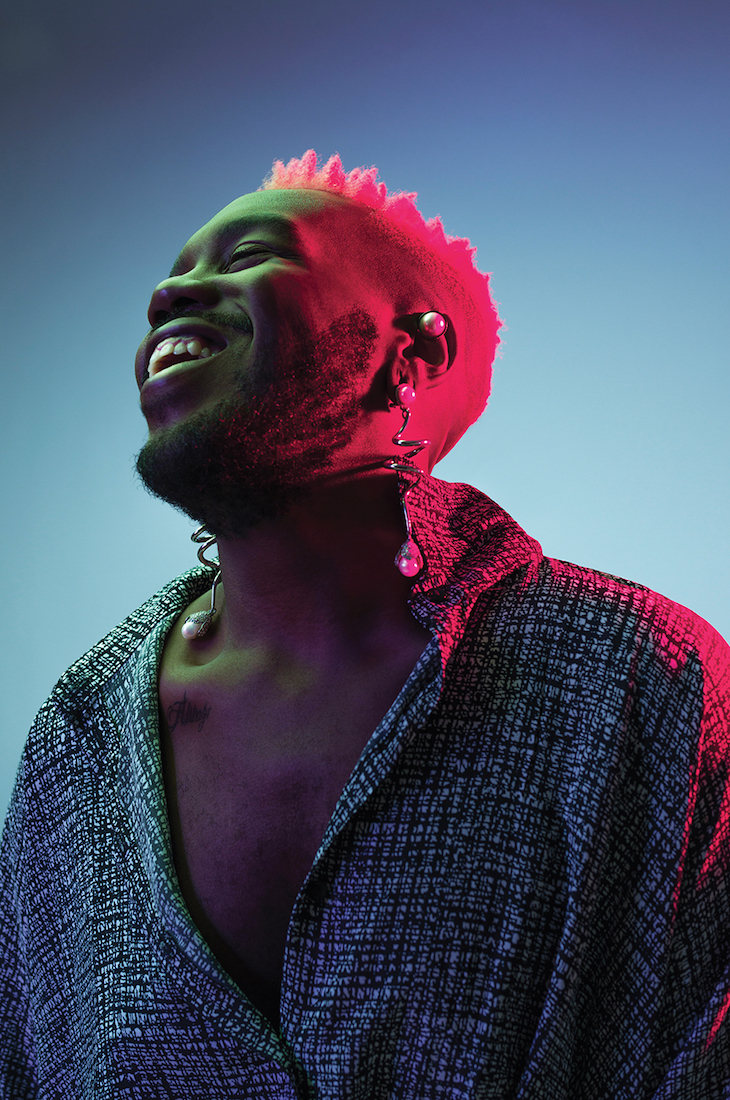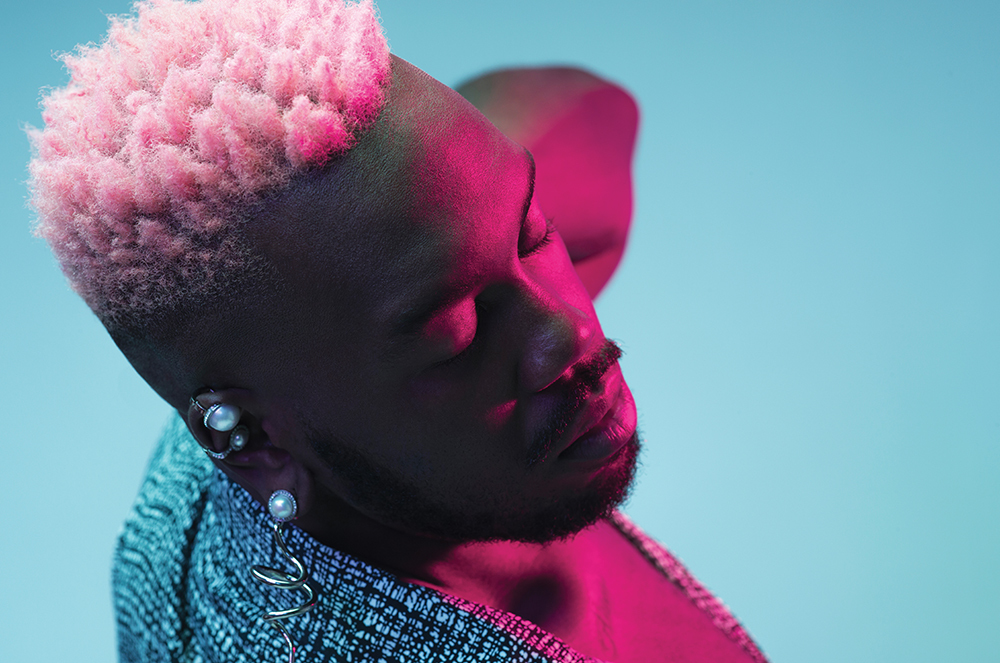Willi Ninja’s dream is alive and Paris is burning. In six short years France’s ballroom scene has distinguished itself from NYC’s legacy and developed its own icons, style, and sound, with producer Kiddy Smile leading the charge on the runway.
Before joining the House of Mizrahi, Kiddy already had one foot in the fashion world and the other in music. Working as a stylist, running his own nights, and DJing across Paris, he caught the attention of Lasseindra Ninja and Mother Steffie Mizrahi. He fell in love with the fledgling movement and an opportunity to be part of a community specifically for black and LGBTI kids.
Influenced as much by disco and dreamy 90s house music as he is by contemporary ballroom, Kiddy brings a nostalgia to his music that’s distinctly French in flavor. As i-D exclusively shares the video for “Let a Bitch Know” on Defected Records, we speak to Kiddy Smile about the video, community, and his incredible ensembles.
Firstly, the video is incredible. Tell us a bit about the individuals you’ve featured in it.
Thank you. We did put a lot of effort into this film so we are really appreciative of such good feedback. I work mostly with my friends and family at this point, so all the beautiful performers that you can see in the video are part of the Paris Ballroom Scene. The Ballroom Scene is a place where LGBTI people of color mainly get to express their talent in various fields, in competitions called Balls. So all of these amazing people are French, and performers. When I exposed them to my idea and asked for help, they all showed up. Ballroom is a place where there is a lot of support, even though we thrive through competitions.
The video places ‘vogue’ outside of its native nightlife setting — what led you to film in an urban environment instead?
Because Ballroom is a place of empowerment and freedom, I always wished the movement had been born in Paris when I was younger — because it would have helped me deal with a lot of issues. But then I was thinking, ‘what if the world was a place of empowerment and freedom and not just about dividing?’ and looking at the way people who filmed voguing in the past did it. I always felt weird because it was a fantasy of what people want us to be and on top of that, fetishizing our life without really trying to get to the roots of the ‘where’ and the ‘why’ we ended up in ballroom.
This is something that is really dear to my heart because we [French ballroom people] mostly all come from a tough urban background and because we are part of the LGBTI community we had to comply and let go of a part of our past. That’s what I was trying to do with my video — reclaiming the street culture and environment that made me the artist I am today.
The clothes are amazing and you’re always dressed impeccably — is fashion an important part of your identity as an artist?
Of course I live for nice and high fashion brands but I think, overall, what I care about is the visuals. Growing up in a modest household with a stylish single mother was very inspiring yet frustrating — not to have the means to control what you could wear or the way you could present yourself, because money was an issue and I have always been fat and tall, which made me an easy target to be picked on. All of it stopped the day I made enough money to buy me the attire of my dreams: that day I understood the power of great visuals and aesthetics. People start changing and I went from being a broke outcast to a trendy stylish student.
We’ve heard you always try to dress like an extra in The Fifth Element. What other inspirations do you draw from?
That is very true; I secretly hope that Luc Besson considers me for a small part in a sequel of this movie! My style is made of a lot of different things, but mostly womenswear garments, because the plus size departments for men are boring. It is a shame there is nothing interesting happening for flamboyant big boys. But to be a little more precise, I like to play with different genres — urban, classique, vintage, sex clothing — and mix them together. Also different types of fabrics like vinyl, leather, fur.
How did you first get involved in the ballroom scene?
Lasseindra Ninja and Mother Steffie Mizrahi, the Paris Ballroom Scene pioneers, approached me to help them organize an event — a ‘function’ in ballroom slang — but it took me a while to actually become an active member of this community. I’m part of the iconic House Of Mizrahi which is based in NYC, but they have a Paris department which is commonly called Paris Chapter. It’s led by the legendary Mother Steffie.

The last year has seen the scene attract a lot of attention worldwide. How is this received by the community?
I think overall everybody is excited to get some attention and recognition for their art form. On my part I’m more cautious about it, since I’m not blind to manipulation and capitalization of queer people of color. What scares me the most is that the people who made this culture happen and the ones who sweated to draw attention to it won’t be the ones getting the money or fame they are entitled to.
Is it difficult being a musician in a scene where it’s performance rather than music that comes first?
I understand why it could be a struggle in an era where every little thing needs to be staged and choreographed for social media and attention, but I feel because I was a dancer I have less problem thinking about my art as a whole. So while making music I always keep in the back of my mind the moment I will have to perform it — whether it’s going to be live or just in a vocal DJ set. I also disagree with the fact that my scene is less music and more performance; I don’t think one has to suffer for another, and they could both exist on the same stage at the same level.
Lots of ballroom anthems are built around the ‘ha ha’s’ and the crashes but “Let a Bitch Know” has a more house feel. How do you like to distinguish your own sound?
I’m a bassline guy! That’s what makes people stand up to dance. I love a round, voluptuous, and sexy bassline, so that’s why this is a very important component to my music. A good groove is important if you want people to dance so I’m always looking for that unexpected rhythm pattern, very laid back — like almost off-beat.
Of course I try to do music that emotes and mostly it translates through the keys and digging for the right sound for synths, but I mostly get my message across with the help of words and vocals. I think this is what sets me apart, the fact that my writing and singing are leaning toward a more popular approach when the sound of the music stays true to the underground music roots I long for, like Frankie Knuckles, Fast Eddie, or Joe Smooth.
As for the ballroom aspect in my music, except for the sass of it, I feel like this is very adequate for ballroom in the sense that in the early nineties when this culture was growing big in the clubs, the music played back then was classic house music 101. When Masters At Work brought the ‘Ha Dance’, that completely changed the game. Ballroom people were getting life from (and they still are) the Salsoul Orchestra, Tyree Cooper, and Ellis D… But l guess you have figured by now that I’m a very nostalgic type of girl.
You’ve spoken before about trying to balance tradition and family with your work and lifestyle. Have you managed to strike an equilibrium?
I don’t think I ever will… maybe when I get a family of my own. My family doesn’t really understand what I do and struggles to see my job as a “real” job because I don’t have office work hours or an office. It’s hard for them to see this as a career because for them if you are not on TV, then your music is just a hobby. I also think that the fact that lots of people, including my family, think of work as something not enjoyable and mine looks fun, therefore I’m not working. Balance with my family’s African background and my work will always be shaky, as my sexual orientation is a big part of my music and who I am and I know that even though they love me to death, they are still trying to cope with everything I put them through every day —which is quite a lot to be honest!
Do you foresee subcultures being affected in an increasingly divided and right-leaning Europe?
Of course division is never a productive place for any type of growth except for evil, and that what is happening right now not only in Europe but all over the world. It is very scary but I feel that if people get more involved in the injustices around them, it could lead to beautiful pieces of art because inspiration in art thrives from oppression. Most of the subcultures were born in reaction to oppression, because there was a need to take a stand for something bigger. So the right-leaning of Europe could be an opportunity for more people to take a stand through their art form, to try to resist, to try to say a piece of truth… That’s what I’ll do.
Credits
Text Alice Lewis
Photography Andre Atangana
All clothing and accesories Balenciaga
